
Last night Patti Smith sang “Beautiful Boy” at the Capitol Offenbach in Offenbach, Germany.
-– A Days of the Crazy-Wild blog post: sounds, visuals and/or news –-

Last night Patti Smith sang “Beautiful Boy” at the Capitol Offenbach in Offenbach, Germany.
-– A Days of the Crazy-Wild blog post: sounds, visuals and/or news –-

Bruce Springsteen began his final (third) show in Perth, Australia Friday night (February 8, 2014) with a tribute to AC/DC in the form of a rousing “Highway To Hell.”
And more:
“The Promise” Feb. 8, 2014:
“Terry’s Song” – Feb. 8, 2014:
“Thunder Road” – Feb. 5, 2014:
“For You” – Feb. 2, 1014:
“I’ll Work For Your Love” – Feb. 7, 2014:
-– A Days of the Crazy-Wild blog post: sounds, visuals and/or news –-
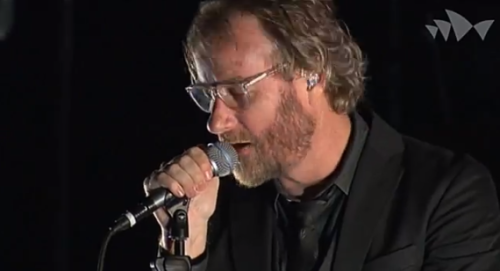
Today The National’s performance at the Sydney Opera House was streamed live and you can watch the whole thing.
Setlist:
Don’t Swallow The Cap
I Should Live In Salt
Mistaken For Strangers
Bloodbuzz Ohio
Demons
Sea Of Love
Hard To Find
Afraid Of Everyone
Conversation 16″
Squalor Victoria
I Need My Girl
This Is The Last Time
Lean
Abel
Slow Show
Apartment Story
Pink Rabbits
England
Graceless
About Today
Fake Empire
Learning (Perfume Genius cover)
Humiliation
Mr. November
Terrible Love
Vanderlyle Crybaby Geeks (acoustic)
-– A Days of the Crazy-Wild blog post: sounds, visuals and/or news –-

On February 6, 2014 Thurston Moore joined The Horrors onstage at The Forum in Kentish Town, London for a performance of “I Can See You.”
Thurston also said his “new band basically consists of myself and another guitar player, James Sedwards.”
Thurston and Sedwards have been working together since last year, and previously performed together in London and Paris.

The Horrors and Thurston Moore, “I Can See You”:
And here’s Thurston performing “Detonation” with James Sedwards:
And here Thurston gets “Living Legend” award” from The Fly magazine, and then Thurston talks about the early days at C.B.G.B.’s and more:
-– A Days of the Crazy-Wild blog post: sounds, visuals and/or news –-
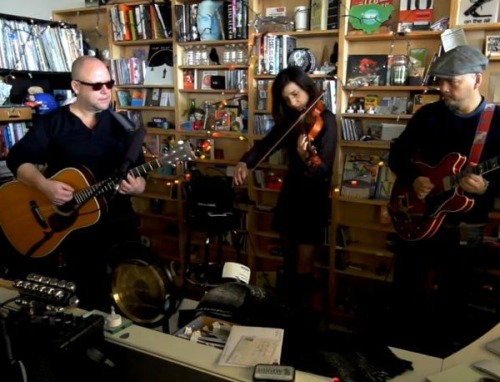
For NPR’s Tiny Deck Concert the Pixies performed “Greens and Blues” off EP-2, the unreleased “Silver Snails” and the “Monkey Gone to Heaven.”
-– A Days of the Crazy-Wild blog post: sounds, visuals and/or news –-

On February 6, 1989, 25 years ago, the album Dylan and the Dead was released.
Rock critics hated the album.
Rolling Stone: [The record] “makes you wonder what the fuss [over the tour] was about…”
The Village Voice, Robert Christgau: [What Dylan] “makes of his catalogue here is exactly what he’s been making of it for years—money.”
Amazon.com, Steve Appleford: “If these were the stadium tour’s best performances, pity anyone who actually sat through one of these concerts with a clear head.”
Listening to the album now, I think it sounds pretty good. No, it’s not among Dylan’s best, but the combo of Dylan and the Dead is a good one. Garcia’s guitar work is, often enough, the perfect compliment to Dylan’s songs, and the Dead’s harmony vocals are just right.
“Queen Jane Approximately” is a standout with outstanding guitar playing from Garcia, a strong performance from the whole band and strong vocals from Dylan.
“Knocking On Heaven’s Door” is a solid performance — it’s great to hear how the Dead handle backing Dylan.
Also quite strong is “All Along the Watchtower.” And, really, “Slow Train” and “Gotta Serve Somebody” aren’t bad either.
The only track I could really do without is “Joey.”
Of course a much better album could have been pulled together if other songs from the tour had been included, as well as some of the songs Dylan and the Dead rehearsed at Club Front in San Rafael, June 1, 1987, before the tour began.
What’s so weird is that there are times during the rehearsals when Dylan’s voice sounds fantastic — like he was more into just jamming on songs with the Dead than when they were actually out on the road.
Here are some performance from the tour and the rehearsals that I like.
“Queen Jane Approximately”:
“It’s All Over Now, Baby Blue,” Eugene, July 19, 1987:
“The Wicked Messenger,” East Rutherford, July 12, 1987:
“The French Girl,” rehearsal:
“When I Paint My Masterpiece,” rehearsal:
“Tomorrow Is A Long Time,” rehearsal with the Dead, 1987:
“Rainy Day Women #12 & 35,” Eugene, July 19, 1987:
“Pledging My Time,’ rehearsal:
“I’ll Be Your Baby Tonight,” rehearsal:
Bob Dylan and Jerry Garcia (vocals), “Señor (Tales Of Yankee Power), first take, rehearsal:
-– A Days of the Crazy-Wild blog post: sounds, visuals and/or news –-
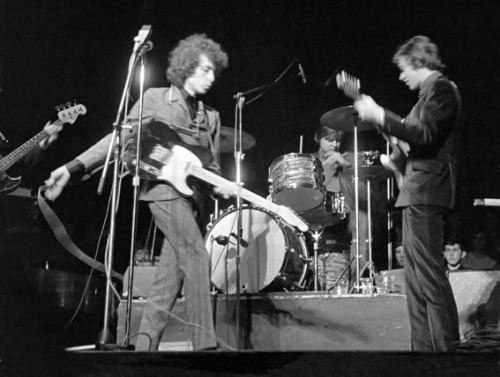
Fifty years ago, on February 5, 1964, “Baby, Let Me Follow You Down” was copyrighted as a Bob Dylan composition, by Whitmark & Sons, Dylan’s song publisher at the time.
But as Tim Dunn details in his book, “The Bob Dylan Copyright Files: 1962 – 2007,” Bob Dylan didn’t write “Baby, Let Me Follow You Down.”
What’s odd about it is that at the beginning of Dylan’s recording of the song for his 1962 Columbia Records debut, Dylan credits Eric Von Schmidt as teaching the song to him.
“I first heard this from Ric Von Schmidt,” Dylan says before starting to sing the song. “He lives in Cambridge. Ric’s a blues guitar player. I met him one day in the green pastures of Harvard University.”
So Whitmark & Sons certainly should have known by February of 1964, more than two years after Dylan recorded the song, that it was not a Dylan original.
Dunn writes that the song can be traced to a 1930 recording by Memphis Minnie and Kansas Joe McCoy: “Can I Do It For You.”
Eventually Blind Boy Fuller recorded a version of “Mama Let Me Lay It On You” in 1938 that, in turn, was adapted by Eric Von Schmidt. Reverend Gary Davis claimed that he taught the song to Fuller, and in 1978 the song was copyrighted as a composition by Davis. (Davis passed away in 1972.)
When Dylan was hanging around Greenwich Village in 1961, he also heard Dave Van Ronk perform a version of “Baby, Let Me Follow You Down.”
In an article Von Schmidt wrote that was published posthumously in the Winter 2008 issue of Sing Out! magazine, he said that Dylan’s version of “Baby, Let Me Follow You Down” was “…a hybrid… probably closer to Dave’s version.” (Von Schmidt passed away in 2007; Van Ronk passed away in 2002.)
When the remastered version of Bob Dylan was released in 2005, the revised credits read: “Rev. G. Davis; add. contributions E. von Schmidt, D. Van Ronk.”
Bob Dylan, “Baby, Let me Follow You Down” off Dylan’s debut album, Bob Dylan:
Memphis Minnie and Kansas Joe McCoy, 1930:
Blind Boy Fuller, “Mama Let Me Lay It On You,” April 1938:
Rev. Gary Davis, “Baby Let Me Lay It On You”:
Bob Dylan and the Hawks, “Baby, Let Me Follow you Down,” Manchester Free Trade Hall, May 17, 1966:
Check out this version by Carly Simon with members of the Hawks backing her in 1966 — it’s not complete. The songs starts in at about 50 seconds into the clip:
Plus more versions from the 1966 World Tour:
Bob Dylan and the Hawks, “Baby, Let Me Follow You Down,” April 13, 1966, Sydney, Australia:
Bob Dylan and the Hawks, “Baby, Let Me Follow You Down,” April 20, 1966, Melbourne, Australia:
Bob Dylan and the Hawks, “Baby, Let Me Follow You Down,” May 14, 1966, Liverpool:
-– A Days of the Crazy-Wild blog post: sounds, visuals and/or news –-
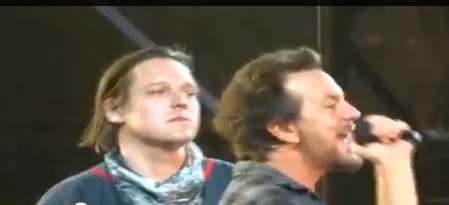
Arcade Fire’s Win Butler joined Pearl Jam in Perth, Australia yesterday for a blistering version of “Rockin’ in the Free World.”
-– A Days of the Crazy-Wild blog post: sounds, visuals and/or news –-
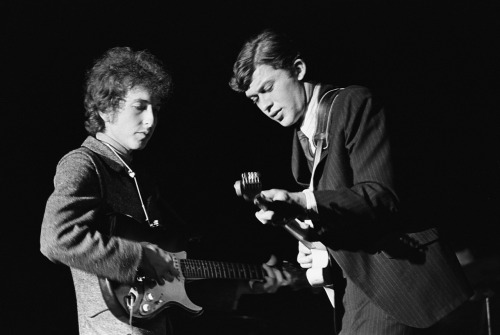
Forty-eight years ago, on February 4, 1966, Bob Dylan and the Hawks kicked off their unprecedented 1966 world tour.
Unprecedented because never before had a popular artist so radically altered their art.
Less than a year earlier, in May of 1965, Dylan had completed a tour of England at the Royal Albert Hall. That tour was documented in “Don’t Look Back,” and during it Dylan remained the folk singer — playing harp and an acoustic guitar.
Dylan was known throughout the world in early 1965 as a folksinger. His first four albums found him playing guitar, harp and piano.
But 17 days after 1965 English tour tour ended, on May 27, 1965, Dylan released Bringing It All Back Home, an album whose first half was a new kind of rock ‘n’ roll, one that mixed caustic poetry with bluesy rock and Dylan’s unique vocals.
Two months later the single “Like a Rolling Stone” was released, and Dylan was a full-fledged rock star.
“Like A Rolling Stone” was a hit, reaching #2 in the U.S. and charting in the Top 10 in a number of other countries including England.
Dylan blew minds when he performed electric rock ‘n’ roll at Newport on July 24, 1965. Dylan and the Hawks played Forest Hills Tennis Stadium in New York on August 28, and then Highway 61 Revisited, Dylan’s first total rock ‘n’ roll album, was released on August 30.
October, November and December found Dylan and the Hawks barnstorming through America.
The 1966 World Tour began in the U.S., but eventually hit Australia and then England, and it was in England, where fans had last seen Dylan with an acoustic guitar, that fans reacted with fury to Dylan going electric.
“They absolutely hated us,” Robbie Robertson said of a tour in which audiences didn’t comprehend some of the greatest rock ‘n’ roll every played.
As Greil Marcus wrote in his book “Invisible Republic – Bob Dylan’s Basement Tapes”: “In America, this music was, in a way, prophetic. At the very least the sound and its reception prefigured an America that, soon enough, for everyone, would be all too familiar: a country split in half over race and war, with battles in the streets, guns fired on college campuses, ghastly riots in cities across the nation, leaders falling to assassins as if on a schedule set by public fantasy, screamers driven from meeting halls with clubs, common citizens driven from their streets with gas and bullets.
“But in the United Kingdom, where after eight months on the road the ensemble had likely reached the limits of their capacities, and reveled at the fact, the hatred for Dylan’s new music and for what he had become was somehow more abstract than in the United States, and more impersonal — uglier.
“It was as if he had betrayed not simply the Freedom Sinfgers, or Woody Guthrie, or the fan who was now shouting, but the Folk immemorial, the mystic chords of memory. The very instinct that history contained identity and one could claim it. In any case the response now made the controversies of the past seasons fade into their own abstraction. In the music Dylan and the Hawks sent off stages in May of 1966, absurdity wars with terror, terror with exultation, exultation with loathing. It was all too much, it couldn’t last and it didn’t.”
Below are live performances from the 1966 World Tour.
“Just Like Tom Thumb’s Blues,” April 13 1966, Sydney:
“I Don’t Believe You (She Acts Like We Have Never Met),” APril 13, 1966:
“Positively 4th Street,” April 13 1966, Sydney:
“Tell Me, Momma,” May 14, 1966, Liverpool:
“Like A Rolling Stone,” May 14, 1966, Liverpool:
“One Too Many Mornings,” May 16, 1966, Sheffield:
“Leopard-Skin Pill-Box Hat,” May 26, 1966, Royal Albert Hall, London:
“Ballad Of A Thin Man,” May 26, 1966, Royal Albert Hall, London:
-– A Days of the Crazy-Wild blog post: sounds, visuals and/or news –-
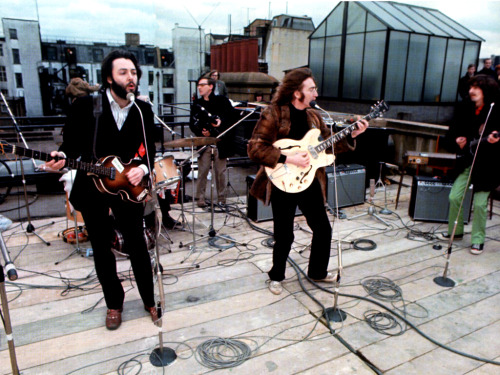
The Beatles on the roof rooftop of Apple, their label, on Savile Row, January 30th, 1969:
The Beatles – Rooftop Concert (London Original… by STARDUST72
Setlist:
1. Get Back
2. Don’t Let Me Down
3. I’ve Got A Feeling
4. One After 909
5. Dig A Pony
6. Get Back
-– A Days of the Crazy-Wild blog post: sounds, visuals and/or news –-